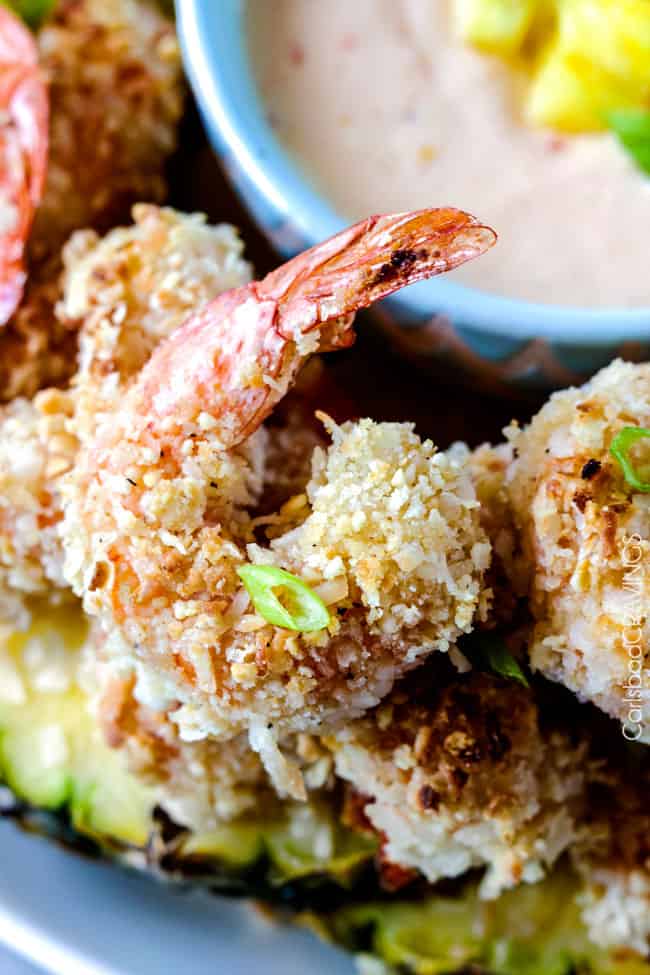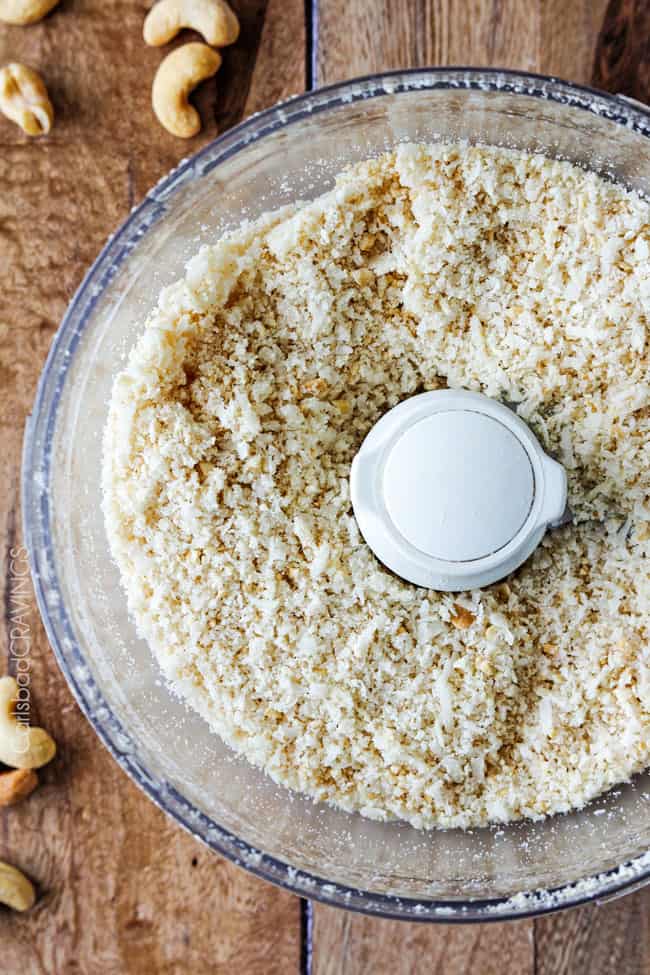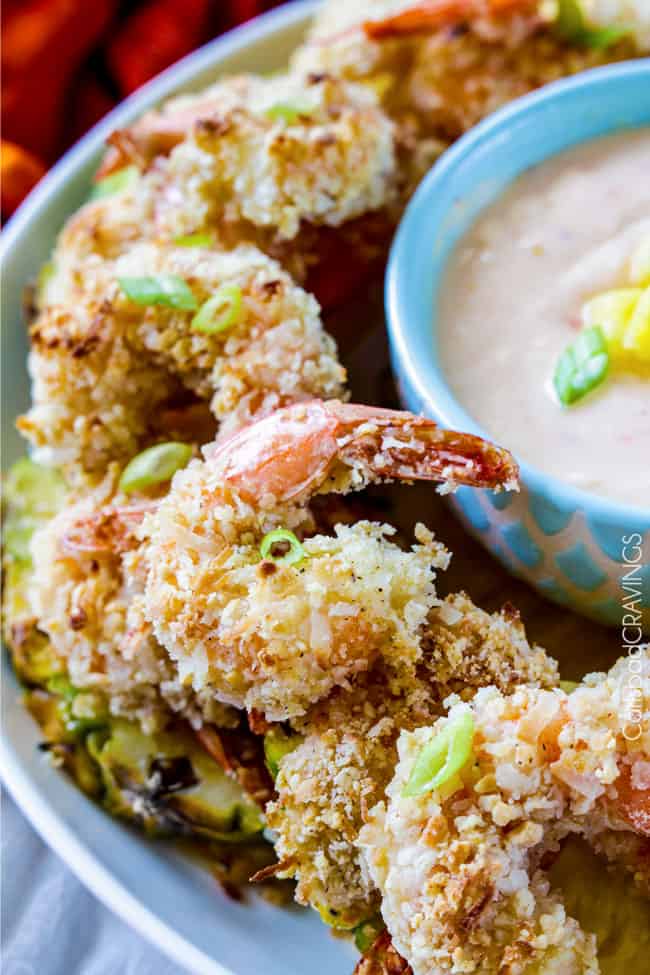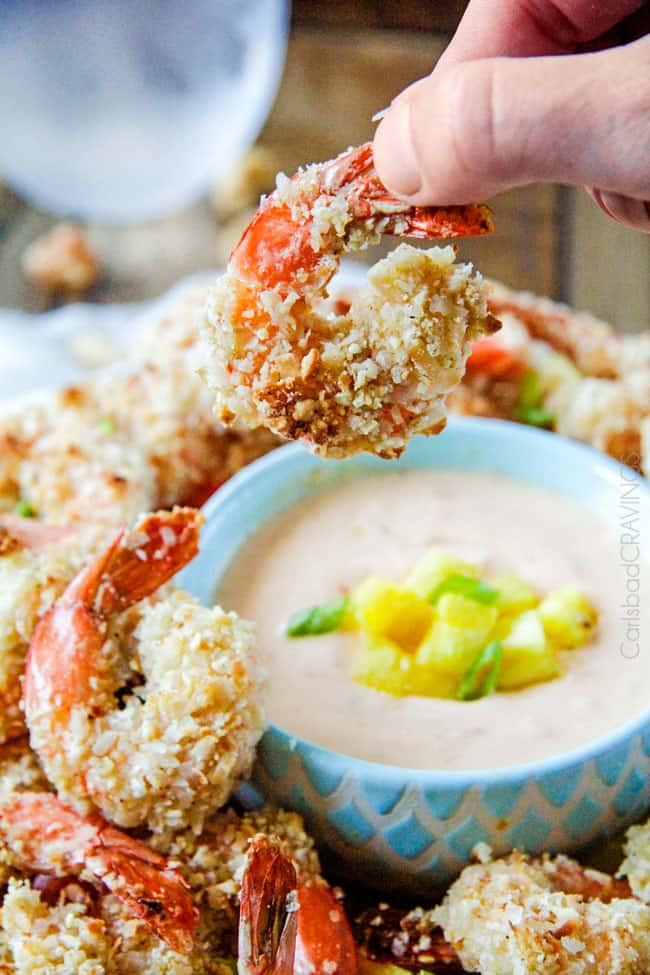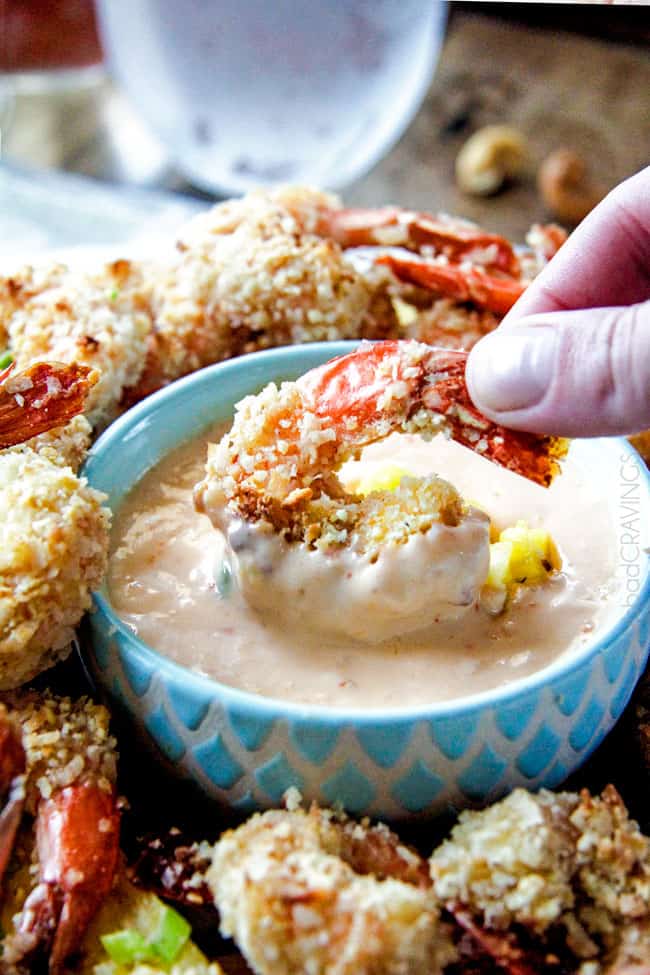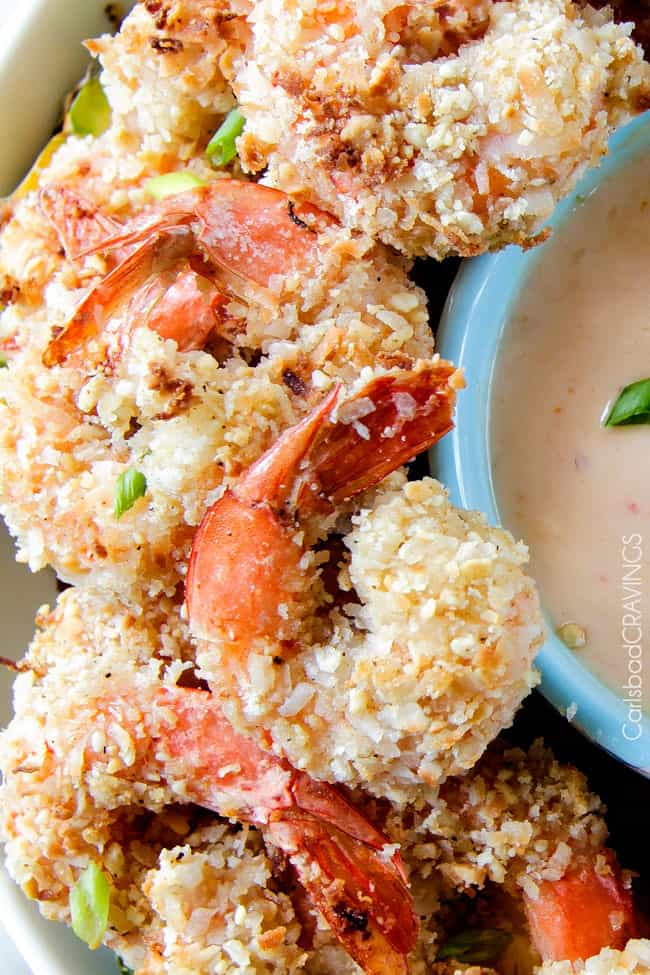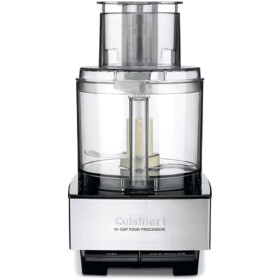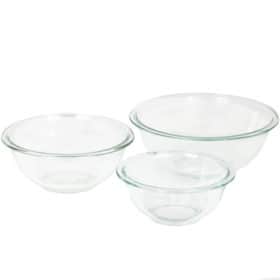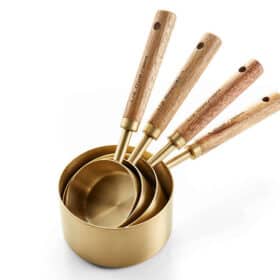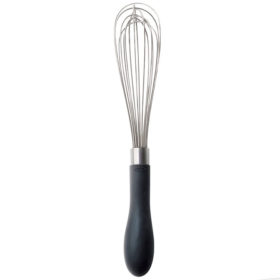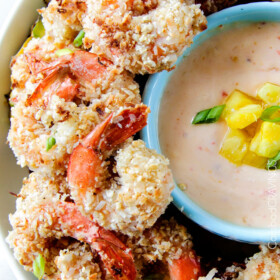Coconut Shrimp Recipe
Few sights get me giddier than a heaping pile of golden, plump, juicy, crunchy Coconut Shrimp. I just see the name “Coconut Shrimp” on a restaurant menu and my heart skips a beat. Does Coconut Shrimp make YOU giddy? If you’ve never had the pleasure of devouring Coconut Shrimp before, it is essentially coconut coated in coconut and typically fried until golden – and it is everything. I wanted to make beloved restaurant Coconut Shrimp at home without the fat of a deep fryer but with all the sweet, crispy taste and then I started to drool reflecting back on my Cashew Coconut Chicken Tenders and I knew what had to be done. I used the same breading technique and created jumbo shrimp enveloped in a blend of roasted cashews, sweet coconut and panko spiced with cumin and ginger – the perfect harmony of nutty, roasted, sweet and spice – and baked to golden, crunchy succulent perfection – without the grease. You will be shocked at how spectacularly delicious this healthy Coconut Shrimp recipe is – and how easy it is to make a home! It is a simple 4 step process: process breading, coat shrimp in flour, dunk shrimp in egg whites, coat shrimp in breading, bake. That’s it for easy Coconut Shrimp!
Where did Coconut Shrimp originate?
While we don’t know exactly where Coconut Shrimp originated, it is suspected to have evolved from the world’s tropical coasts of southeast Asia where there an abundance of both shrimp and coconuts Southeast Asian cuisine boasts lots of seafood and coconut flavors so it seemed like a match made in heaven – and it tastes like one! It can now be found on menus across the world – and now in your kitchen!
What do you need to make Coconut Shrimp?
You only need a handful of ingredients to make this delightful finger appetizer:
Jumbo shrimpFlourEgg whitesCooking spraysweetened coconut flakesroasted salted cashewspanko breadcrumbs
What kind of coconut do you recommend?
I recommend sweetened coconut flakes found in the baking aisle and would stay clear of the unsweetened coconut flakes. Sweetened coconut flakes are the only sweet aspect of this Coconut Shrimp recipe and therefore the sweet in the sweet and crispy and the ideal compliment to the salty cashews.
Why should I use Panko?
If you aren’t familiar with panko, it is a Japanese bread crumb that can be found next to traditional breadcrumbs at your grocery store. If you can’t find it there, it might be in the Asian section. Panko are large flakes that are made from crustless bread. They are larger and airier than normal breadcrumbs so they absorb less moisture which means your Coconut Shrimp gets crispier!
WHAT SHRIMP is best for Coconut Shrimp?
For this baked Coconut Shrimp recipe, you are going to want to use shrimp that is:
16-20 count/poundRawShelledDeveinedDefrosted (if it’s been frozen)
Why use jumbo shrimp?
Is eating shrimp veins bad?
If you purchase shrimp that does not specify it is “deveined” then it will still have the dark, sandy intestinal tract running along the back of the shrimp just beneath the surface. Sometimes it will be very dark and sometimes it will be harder to spot. It simply depends on when the shrimp ate last before it was caught. While eating the shrimp with the veins won’t harm you, it can add grittiness and distract from the clean shrimp taste. The shrimp will taste far superior if they are removed and therefore your Coconut Shrimp will taste far superior!
Is frozen shrimp deveined?
The shrimp bag at the grocery store will indicate if the shrimp is deveined or not. I purchase my shrimp at Costco and always look for the bag that says “deveined.” You want to purchase deveined if possible because then its one less thing you have to do!
How do you clean shrimp before cooking?
Although purchasing deveined shrimp is preferable, deveining shrimp is easy to do, so don’t be afraid if you have never done it before.
HOW DO I DEFROST SHRIMP?
I am a huge fan of frozen shrimp and use it often in my recipes, but I don’t often use jumbo shrimp, so I prefer to purchase my shrimp from the seafood counter at the grocery store that is raw, fresh, shelled and deveined and all ready to go. You can, however, use frozen shrimp but you will need to defrost it first. To defrost shrimp:
Quick Defrost: Place the frozen shrimp in a colander then place the colander in a large bowl. Fill the bowl with cold tap water and let it sit for 10 minutes. After 10 minutes, replace the water with new cold tap water and submerge the shrimp again. Let shrimp sit an additional 10- 20 minutes. If the shrimp isn’t completely defrosted, then repeat.Easy Defrost: The easiest way to defrost your shrimp in the refrigerator overnight.
SHRIMP TAILS ON OR OFF?
I definitely recommend leaving the tails on for this healthy Coconut Shrimp Recipe. The tail creates a built-in handle to grab creating the ideal finger food or appetizer.
Is it okay to eat shrimp tails?
Absolutely, but it doesn’t mean they taste good! Shrimp tails that are boiled or baked are not as desirable as deep-fried shrimp tails because those emerge crispy – so it’s your call.
CAN I PREP COCONUT SHRIMP IN ADVANCE?
You can prep part of your Coconut Shrimp recipe in advance, but I don’t recommend cooking them because the shrimp won’t be quite as crispy when reheated. To prep in advance, whisk together the Coconut Shrimp sauce, cover and store in the refrigerator until ready to use. You can also make the breading in advance by processing the cashews, panko and coconut flakes, mixing together and storing in an airtight container or freezer bag.
How to Make Coconut Shrimp
You can make Coconut Shrimp in as little as 30 minutes if you use deveined shrimp. To make, you will create three breading stations: the breading, the flour and the egg whites. STATION 1: To the first bag, add ¾ cup flour. Flour ensures he egg whites will stick to the shrimp. STATION 2: Next, beat the egg whites until frothy in a separate medium bowl. Egg whites are the glue that ensure the breading will stick to the shrimp. Egg whites also produce a lighter product than adding all the protein of a whole egg. STATION 3: Make the breading by processing cashews, coconut flakes and panko until they are all uniform size. I use my food processor and it literally takes a couple pulses. Place the breading in a freezer size bag. BREAD: Add shrimp to the flour, shake until evenly coated. Working one by one, remove shrimp from the flour, shake off any excess and dip in egg whites, remove dab off any excess off with paper towels, then coat in the Cashew Coconut. Make sure you press the mixture firmly to adhere but don’t worry about them looking perfect.
Can you bake frozen Coconut Shrimp instead of frying them?
Yes! That is my preferred method and how we are going to cook the shrimp in this Coconut Shrimp recipe. The shrimp doesn’t emerge quite as golden, but it still tastes wonderfully sweet, crunchy and crispy. The addition of cashews also makes up for some of the crunch lost by baking instead of frying. How To bake Coconut Shrimp:
Coconut Shrimp Sauce
My favorite Sauce for Coconut Shrimp is Pineapple Sweet Chili Dip. It’s a sweet and spicy and blend of pineapple yogurt, Asian Sweet Chili Sauce, honey and mayonnaise to create a tangy, sweet and spicy tropical heavenly dip. If you aren’t familiar with Asian Sweet Chili Sauce, it can be found in the Asian section of your grocery store and is sometimes calls Thai Sweet Chili Sauce (I use Mae Ploy brand), and I am obsessed! Asian Sweet Chili Sauce is made of chilies, sugar, vinegar and garlic and is the perfect balance of sweet and spicy. It is the secret ingredient in my Mongolian Beef and the star of my Sesame Chicken, so if you don’t think you have room in your refrigerator for one more condiment – I promise it is SO worth it! Now go dip your Cashew Coconut Shrimp one-by-one into the velvety palate pleasing Pineapple Sweet Chili Dip. And get giddy.
What other sauces can I serve with Coconut Shrimp?
Asian Sweet Chili SauceApricot, peach or pineapple preserves mixed with chili sauceDijon mustard plus mayonnaiseSriracha aioli dip (if you like it spicy)
What Should I serve with Coconut Shrimp?
Coconut Shrimp can be served as an appetizer or a main dish. For an appetizer you can pair it with other irresistible appetizers of Pineapple Cream Cheese Wontons, Potstickers, or Chinese Chicken Egg Rolls. For a main course, you can serve Coconut Shrimp with Pineapple Rice, Cilantro Lime Rice, Pina Colada Salad, a big green salad or add it to Asian Salad or Chinese Salad to make the best salad EVER!
How long will my leftovers last?
Coconut Shrimp should be stored in an airtight container in the refrigerator. When stored correctly, your shrimp should last for up to three days.
How can I reheat leftover Coconut Shrimp?
You can reheat Coconut Shrimp but they taste far superior freshly baked because once refrigerated or frozen, the shrimp will lose much of its crunch. You may want to half the recipe and bake just what your family can eat. If you do have leftover Coconut Shrimp, I recommend reheating it in the oven to preserve the texture. To reheat in the oven, preheat oven to 350 degrees. Bake until warmed through, about 5-8 minutes with a minimum internal temperature of 145 degrees F.
Can you bake frozen coconut shrimp?
For the crunchiest shrimp, I recommend consuming them freshly baked but yes, you can freeze Coconut Shrimp then bake to reheat. To freeze: Now go dip your Cashew Coconut Shrimp one-by-one into the velvety palate pleasing Pineapple Sweet Chili Dip. And get giddy.
Carlsbad Cravings© Original Tag @CarlsbadCravings and Use #CarlsbadCravngs Leave a Review, I Always Love Hearing From You!

